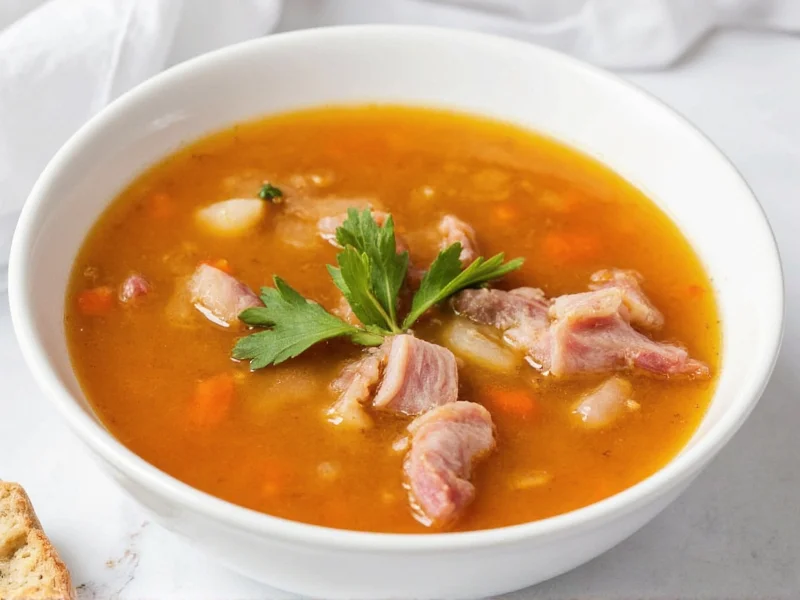Transforming a leftover ham bone into comforting, flavorful soup is one of the most economical kitchen practices you can master. This versatile ingredient creates deeply savory broths that serve as the foundation for numerous hearty recipes. Whether you have a holiday ham leftover or purchased a bone specifically for soup-making, you're holding culinary gold that deserves proper attention.
Why Ham Bones Create Superior Soup Bases
Ham bones contain collagen-rich connective tissues and residual meat that slowly break down during simmering, creating complex flavors you can't replicate with store-bought broth. The natural gelatin released gives soups a luxurious mouthfeel while providing gut-healthy benefits. Unlike commercial broths that often contain excessive sodium, you control the seasoning when making soup from scratch with your ham bone.
Proper Ham Bone Preparation Techniques
Before creating your soup, properly prepare your ham bone for optimal results:
| Preparation Step | Key Details | Time Required |
|---|---|---|
| Storage Before Use | Refrigerate within 2 hours of cooking; use within 4 days or freeze for up to 3 months | Immediate |
| Cleaning | Rinse under cold water; remove large meat chunks for later addition | 2-3 minutes |
| Breaking | Ask butcher to break bone or use kitchen shears for smaller pieces | 5 minutes |
| Meat Removal | Save 1-2 cups of meat for final soup addition after broth preparation | 10 minutes |
Master Ham Bone Broth Recipe
This foundational broth serves as the base for all ham bone soups. Prepare it first, then transform it into your preferred soup variation.
Ingredients
- 1 ham bone (about 1-2 pounds)
- 12 cups cold water
- 1 large onion, quartered
- 2 carrots, roughly chopped
- 2 celery stalks, roughly chopped
- 4 garlic cloves, smashed
- 2 bay leaves
- 1 teaspoon whole black peppercorns
- Small bunch fresh parsley
Instructions
- Place ham bone in a 6-8 quart stockpot and cover with cold water.
- Add all vegetables and seasonings.
- Bring to a gentle simmer (do not boil rapidly) over medium heat.
- Reduce heat to low, partially cover, and simmer for 3-4 hours.
- Remove bone and strain broth through a fine-mesh sieve.
- Cool completely before using or storing.
Five Exceptional Soup Recipes Using Ham Bone Broth
Classic Split Pea Soup with Ham Bone
This traditional recipe showcases how to make split pea soup with ham bone for maximum flavor development.
Ingredients
- 8 cups prepared ham bone broth
- 2 cups dried green split peas, rinsed
- 1 ham bone (meat removed and reserved)
- 1 large onion, diced
- 2 carrots, diced
- 2 celery stalks, diced
- 2 garlic cloves, minced
Instructions
- Sauté onion, carrots, and celery in olive oil until softened.
- Add garlic and cook for 1 minute.
- Pour in broth and add split peas.
- Simmer uncovered for 60-90 minutes until peas are tender.
- Remove ham bone, add reserved meat, and season to taste.
Creamy Ham Bone Potato Soup
A rich, comforting option perfect for cold weather that demonstrates how to make creamy soup with ham bone.
Ingredients
- 6 cups ham bone broth
- 1.5 pounds Yukon Gold potatoes, diced
- 1 cup reserved ham meat, diced
- 1 cup heavy cream or full-fat coconut milk
- 1/4 cup all-purpose flour
- 1/4 cup butter
- 1 small onion, finely chopped
Instructions
- Melt butter and whisk in flour to create roux; cook for 2 minutes.
- Gradually whisk in broth until smooth.
- Add potatoes and simmer until tender (15-20 minutes).
- Stir in cream and reserved ham; heat through without boiling.
- Season with black pepper and fresh thyme.
Troubleshooting Common Ham Bone Soup Issues
Even experienced cooks encounter challenges when making soup recipes using ham bone. Here's how to address frequent problems:
- Broth too salty: Add peeled potato chunks while simmering—they absorb excess salt. Alternatively, dilute with unsalted broth or water.
- Weak flavor: Simmer longer with additional aromatics, or reduce broth by boiling rapidly to concentrate flavors.
- Cloudy appearance: Avoid boiling vigorously; strain through cheesecloth for crystal-clear broth.
- Fat separation: Chill broth completely, then remove solidified fat from surface before reheating.
Storage and Freezing Best Practices
Proper storage extends your ham bone soup's life and preserves flavor:
- Refrigeration: Store in airtight containers for up to 4 days. Cool completely before refrigerating.
- Freezing broth: Portion into 2-4 cup containers or ice cube trays for versatile use. Label with date and contents.
- Freezing finished soup: Most soups freeze well for 3-4 months. Avoid freezing soups with dairy or potatoes (they become grainy).
- Reheating: Thaw frozen soup overnight in refrigerator. Reheat gently over medium-low heat, stirring occasionally.
Maximizing Your Ham Bone Investment
One ham bone can yield multiple meals through strategic planning. Start with basic broth, then transform it into different soups throughout the week. The initial simmering extracts maximum flavor, while subsequent uses create lighter broths perfect for weekday meals. This approach exemplifies economical cooking while reducing food waste—turning what might become trash into treasure.











 浙公网安备
33010002000092号
浙公网安备
33010002000092号 浙B2-20120091-4
浙B2-20120091-4